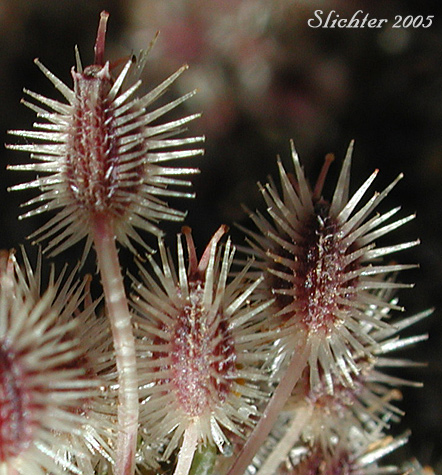 The
photo at right shows a cluster of the spiny fruits of wild carrot. Photographed
along Rd #23 at the Mt. Adams Viewpoint about one-half mile south of its intersection
with Rd #8810.........September 25, 2005.
The
photo at right shows a cluster of the spiny fruits of wild carrot. Photographed
along Rd #23 at the Mt. Adams Viewpoint about one-half mile south of its intersection
with Rd #8810.........September 25, 2005.
Also known as wild carrot, devil's-plague, lace-flower, and bird's-nest, Queen Anne's lace is a biennial herb very similar to the cultivated carrot. The hollow stems are up to 150 cm high and are reddish purple near the base and covered with bristly hairs. The upper stems may be branched. The white taproot is somewhat woody and less than 5 cm in diameter. The leaves are clustered near the base, while those on the stems are alternate and smaller. They are divided into 2-4 narrow segments which are lace-like in appearance. The basal leaves range from 5-40 cm long with long petioles while the upper leaves are stalkless with white papery sheaths at the base.
The inflorescence is a complex, umbrella-shaped inflorescence known as an umbel. The umbel measures from 6-15 cm across and actually consists of as many as 100 smaller umbels known as umbelets. The flowers are composed of 5 small green sepals, 5 white petals, 5 stamens and 2 styles. The whitish umbel is slightly rounded across the top, and has a single purplish-black flower in the center. A whorl of finely divided green bracts with 3-5 branches may be found beneath each umbel. As the fruits mature, the umbel closes upwards, resembling a bird's nest. When the fruits are mature, the umbel flattens down again before releasing its seeds.
Queen Anne's lace may commonly be found along roadsides, in pastures, gardens, and waste areas.
Queen Anne's lace was introduced to the United States in 1739 from Europe, southwest Asia, and north Africa. It is fairly well spread in disturbed places across North America. Plants are restricted to areas with at least 120 frost-free days and from 80-100 cm of rainfall.
It may be found in the Columbia River Gorge between the elevations of 0'-1700' from near the Sandy River in the west and eastward to near the Dalles, OR.